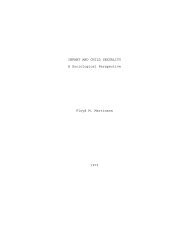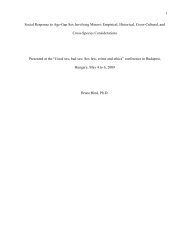PDF file - Ipce
PDF file - Ipce
PDF file - Ipce
You also want an ePaper? Increase the reach of your titles
YUMPU automatically turns print PDFs into web optimized ePapers that Google loves.
The Effects of Early Sexual Experiences pagina 1 van 26<br />
The Effects of Early Sexual Experiences: A review and<br />
Synthesis of Research<br />
Larry L. Constantine<br />
(from Children and Sex – Constantine & Martinson (eds) Little, Brown, Boston<br />
Presented at the conference, Enfance et Sexualite, University of Quebec at Montreal,<br />
September 1979.<br />
Scope of the study<br />
Outcomes<br />
Table of content<br />
Table 1: Outcome of research on childhood sexual encounters<br />
Harm<br />
Table 2: Number of studies reporting various outcomes by type of<br />
sample<br />
Table 3: Number of studies reporting various outcomes by duration<br />
of effects studied<br />
Reactions<br />
Guilt<br />
Anxiety and fear<br />
Self-evaluation<br />
Sexualization<br />
Initiation and participation<br />
Power<br />
Force and coercion<br />
Age<br />
Choice and consent<br />
Family<br />
Environment<br />
Familiarity<br />
Conclusions and syntheses<br />
A model of outcome<br />
Sexualization<br />
Consent<br />
Knowledge<br />
Table 4: Guilt and anxiety as a function of consent and knowledge in<br />
childhood sexual experiences<br />
<strong>file</strong>://G:\Microsoft FrontPage\webs\ipceweb\Library\constantine79_article.htm 10-3-01
The Effects of Early Sexual Experiences pagina 2 van 26<br />
Differentiation sexual experience of adults and children<br />
Remarks<br />
References<br />
SCOPE OF THE STUDY<br />
This study began in 1972 as an unstructured review of the literature on the effects of<br />
incest and other types of sexual encounters between adults and children. However, as<br />
questions about childhood sexuality and particularly the effects of early experiences<br />
became subjects of considerable debate and no small controversy, it was deemed<br />
appropriate to expand the project, to include sexual encounters between children, and<br />
complete it. This review is still by no means comprehensive; it is fact, selective in that it<br />
deals with a body of research and clinical literature concerned with the outcome of<br />
childhood sexual experiences, that is, with both the immediate and the ultimate impact<br />
of the experience. The primary criterion for inclusion was that a study either report<br />
differential outcome or contain material relevant to an attempt to count for differential<br />
outcome (single case reports are excluded). The chapter therefore ignores the sizable<br />
literature on offenders (the adult participants) as well as investigations on what might<br />
be termed the epidemiology of incest and sexual abuse. Many oft-cited sources were<br />
consulted but, because of their focus on treatment considerations or adult offenders to<br />
the exclusion of impact on the children, were not included in the tabulations for this<br />
study (e.g., Cormier et al., 1962) Reviews (Gagnon and Simon, 1970; Henderson, 1972)<br />
and opinion and speculative writings on the subject were examined but not tabulated.<br />
In all, 30 studies of the impact of childhood incest and sexual encounters with adults<br />
were analyzed (Table 17 – 1). These studies cover a span of more than 40 years (although<br />
half are from the last 15 yea and include over 2500 subjects reporting early sexual<br />
experiences. With the exception of the Bender and Grugett (1952) follow-up of subjects<br />
originally reported by Bender and Blau (1937), there is no known overlap, although part<br />
of the Chaneles (1967) and Tormes (1968) studies may have drawn on the same<br />
population. Twelve sources (studies of clinical populations) are clinical case analyses or<br />
studies of subjects in psychotherapy; nine (studies of legal populations) deal with<br />
criminal cases brought to the attention of legal authorities; the remaining nine employed<br />
primarily nonclinical, noncriminal samples obtained in various ways (general population<br />
studies).<br />
The outcome studies reviewed may be considered to be of three types: (1) research on<br />
children shortly after the experience occurred, (2) research specifically on adult<br />
adjustment of subjects known to have had such experiences as children, and (3) research<br />
involving adults who are incidentally discovered to have had such experiences. Only<br />
five studies are of the last type (Benward and Densen-Gerber, 1975; Finkelhor, Chapter<br />
11 in this volume, 1978; Gagnon, 1965; James and Meyerding, 1977; Landis, 1956). Ten<br />
are of the first type, 13 of the second. One (Lukianowicz, 1972) has elements of all three.<br />
The studies investigated populations ranging from two (Yorukoglu and Kemph, 1966)<br />
to 500 (Landis, 1956) and research methodology ranging from questionnaires and sexual<br />
autobiographies to case records analyses and in-depth interviews. The sophistication of<br />
design and care in reporting range from passable to excellent, Included in the<br />
<strong>file</strong>://G:\Microsoft FrontPage\webs\ipceweb\Library\constantine79_article.htm 10-3-01
The Effects of Early Sexual Experiences pagina 3 van 26<br />
compilation are four studies of general populations – Bernard (1979, and Chapter 15 in<br />
this volume), Finkelhor (Chapter 11), Nelson (Chapter 13), and Symonds et al. (Chapter<br />
12) – published in this volume. Two of these (Symonds et al. and Nelson) employed a<br />
novel technique to obtain subjects: ads were placed in periodicals asking to hear from<br />
people with incest experiences.<br />
The most sophisticated studies are also among the most recent. Meiselman (1978) not<br />
only integrates a thorough and critical review of the literature on incest with her own<br />
findings on 58 incest participants in psychotherapy, but also uses for comparison a<br />
control group of 100 subjects selected at random from among other patients of the same<br />
clinic. Tsai et al. (1979 and Chapter 16 in this volume) utilize two control groups,<br />
comparing sexual victims who sought therapy or counseling to both those who never<br />
sought such help and a control group of nonvictims. Their informants were solicited as<br />
in the Symonds and Nelson studies. Finkelhor bases his sophisticated data analysis on a<br />
survey of nearly 800 students at six New England colleges and universities.<br />
The sexual experiences of interest in this chapter are both incestuous and nonincestuous<br />
encounters between children and their age peers and between children and adults or<br />
substantially older partners. Of the four categories of interest, only three are represented<br />
in the literature reviewed: incest with peers, incest with nonpeers, and other sexual<br />
encounters with nonpeers. The fourth category, nonincestuous experiences with other<br />
children, is not well represented in the outcome literature, although it has often been the<br />
focus of anthropological and ethnographic study. (See both Currier, 1979 and Chapter 2<br />
in this volume, and Berger, Chapter 18 in this volume.)<br />
For purposes of this chapter, studies of incestuous and nonincestuous encounters have<br />
been aggregated for two reasons. The first was a matter of practicality, in that twice as<br />
many outcome studies of incest have been made and, of the third of the studies under<br />
review that dealt primarily with nonincestuous experiences, over half also included<br />
some cases of incest. It was also a matter of theoretical importance, since there is an open<br />
empirical question whether incest is more or less damaging than sexual encounters with<br />
non–family members; this issue can only be addressed by including studies of both<br />
phenomena.<br />
For similar reasons, no sharp upper limit on age of subjects was set. It is a matter of<br />
some debate, especially in the psychoanalytical literature, whether incest is more<br />
injurious prior to or after puberty. Certainly age warrants investigation as a possible<br />
factor in differential outcome. Thus, some studies tabulated deal with subjects whose<br />
experiences may have occurred in late adolescence, although prepubertal experiences<br />
account for the greatest proportion and the two largest studies deliberately limited their<br />
sample to these.<br />
OUTCOMES<br />
This chapter will make reference to negative, neutral, and positive outcomes. A negative<br />
outcome is a finding or conclusion that childhood incest or other sexual encounters were<br />
disturbing or traumatic or impaired the children who participated (at the time or later,<br />
as adults) in social, emotional, or intellectual functioning. All the studies reviewed but<br />
one report some negative outcomes. In some instances negative outcomes are inferred<br />
<strong>file</strong>://G:\Microsoft FrontPage\webs\ipceweb\Library\constantine79_article.htm 10-3-01
The Effects of Early Sexual Experiences pagina 4 van 26<br />
from the nature of the study: the two studies<br />
Study (See<br />
References)<br />
1 Bender & Blau<br />
(1937)<br />
Table 17-1. Outcome Research on Childhood Sexual Encounters<br />
2 Bender & Grugett<br />
(1952)<br />
3 Benward &<br />
Densen-Gerber<br />
(1975)<br />
Type of Experience N a Sample Source Outcome<br />
Reported<br />
b<br />
Term of<br />
Effects<br />
Studied<br />
Various prolonged 16 Psychiatric hospital 0 to - Short<br />
Various prolonged 14 Follow-up of above 0 to - - Long<br />
Parental, sibling<br />
incest<br />
4 Bernard (1979) Drug treatment<br />
center<br />
5 Browning &<br />
Boatman (1977)<br />
Parental, other<br />
incest<br />
52 Drug treatment<br />
center<br />
30 Convenience<br />
sample<br />
14 Child guidance<br />
clinic<br />
- to - - Medium<br />
to long<br />
+ to - Long<br />
- - to 0 Short<br />
6 Brunold (1964) Assault 62 Court records 0, + to - - Long<br />
7 Chaneles (1967) Assault, paternal<br />
incest<br />
159 Agency case<br />
records<br />
- Long<br />
8 Finch (1973) Various 10 Private practice - to (0) Short<br />
9 Finkelhor (1981) Sibling incest 144+ College students 0, - to + Medium<br />
to long<br />
10 Gagnon (1965) Prepubertal, with<br />
adults<br />
11 Greenland (1958 Parental, sibling<br />
incest<br />
12 Ingram (1979) Homosexual, with<br />
adults<br />
13 James &<br />
Meyerding (1977)<br />
14 Justice & Justice<br />
(1979)<br />
Early sex with<br />
older partner<br />
Parental, sibling<br />
incest<br />
333+ "Kinsey" study 0 to - Long<br />
7 Advice column - to 0 Medium<br />
to long<br />
74 Counseling clients 0 to + Short to<br />
medium<br />
109 228 prostitutes - to - - Long<br />
112 Clinical - to - - Long<br />
15 Landis (1956) Sex with adults 500+ University students 0 to – Medium<br />
to Long<br />
16 Lukianowicz (1972) Parental, other<br />
incest<br />
55 General hospital<br />
patients<br />
0 to - Short to<br />
long<br />
17 Meier (1948 Various 100 Court cases - to - - Short<br />
18 Meiselman (1978) Parental, other<br />
incest<br />
58+ Psychiatric clinic - - to 0 Short to<br />
long<br />
<strong>file</strong>://G:\Microsoft FrontPage\webs\ipceweb\Library\constantine79_article.htm 10-3-01
















